May 29 – June 1, 2016 —
The Cappadocia region, in central Turkey, was on our bucket list for Turkey. A geological wonder made up of caves dwellings and “fairy chimneys”.
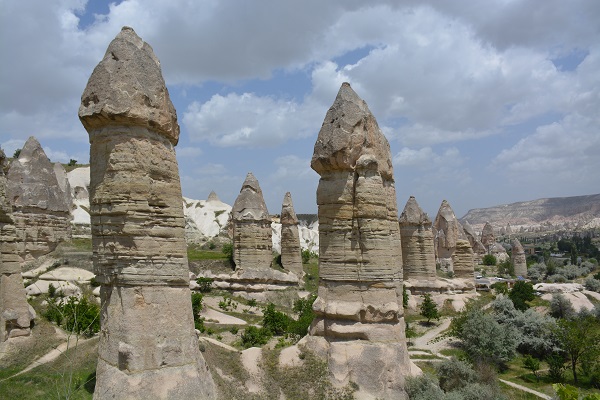
The fairy chimneys are unique mushroom shaped rock formations that developed over millions of years, first by volcanic eruptions then by erosion. It is likely one of the most photographed areas of Turkey.
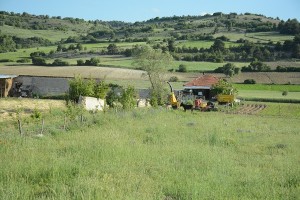 Over the first two days we traveled about 10 hours by van, on well paved highways across mostly plains. This area is very scenic with ornamental trees and flowering bushes all along the roadside. This is a big agricultural area made up of mostly small family farms which dotted the landscape one right after the other. Turkey is a major producer of fruits and vegetables, exporting to neighboring countries what is not consumed locally.
Over the first two days we traveled about 10 hours by van, on well paved highways across mostly plains. This area is very scenic with ornamental trees and flowering bushes all along the roadside. This is a big agricultural area made up of mostly small family farms which dotted the landscape one right after the other. Turkey is a major producer of fruits and vegetables, exporting to neighboring countries what is not consumed locally. 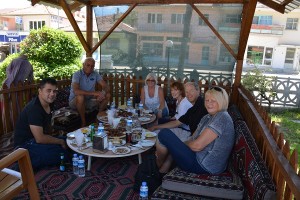 Along the way we stopped at local spots for lunch or other fresh snacks. One stop was a Kurdish roadside stand to buy fresh fruit. The entire family participated in the business.
Along the way we stopped at local spots for lunch or other fresh snacks. One stop was a Kurdish roadside stand to buy fresh fruit. The entire family participated in the business. 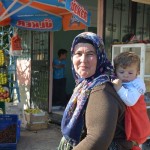 May and June is cherry season in Turkey with the best cherries we have ever tasted. We enjoyed them throughout the trip.
May and June is cherry season in Turkey with the best cherries we have ever tasted. We enjoyed them throughout the trip.
Day two, we saw Esrefoglu Mosque in Beysehir which is the only wooden mosque in Turkey and is over 700 years old. Columns inside the mosque, usually stone are made out of cedar. 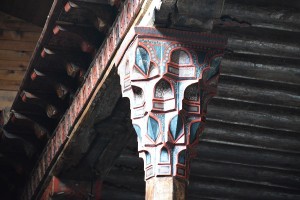 During renovations in the 20th century the open central skylight in the ceiling was glassed up to keep the weather out. Unfortunately, the structure that stood for hundreds of years with an open architecture started to fail. Large humidifiers were brought in to raise the humidity level to the natural environment to arrest the deterioration.
During renovations in the 20th century the open central skylight in the ceiling was glassed up to keep the weather out. Unfortunately, the structure that stood for hundreds of years with an open architecture started to fail. Large humidifiers were brought in to raise the humidity level to the natural environment to arrest the deterioration. 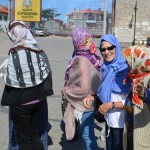 This mosque is one of the best examples of Ottoman architecture where many structural materials were combined, including: wood, stone, tile, brick and fresco. Women had to wear hijabs and men long slacks to enter.
This mosque is one of the best examples of Ottoman architecture where many structural materials were combined, including: wood, stone, tile, brick and fresco. Women had to wear hijabs and men long slacks to enter.
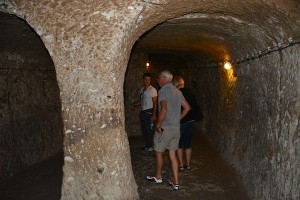 Across Cappadocia there is a network of underground cities. Thirty-seven have already been opened and there are believed to be more than one hundred more. During the 6th and 7th centuries Byzantine Christians attempted to evade capture and persecution by invading armies by moving into the underground cities for months at a time. The cities included schools, hospitals, and spaces to keep their animals. Air shafts, disguised as wells, provided ventilation to the floors below ground. Some shafts are up to 300 feet deep. We were at the city of Derinkuyu which has seven levels.
Across Cappadocia there is a network of underground cities. Thirty-seven have already been opened and there are believed to be more than one hundred more. During the 6th and 7th centuries Byzantine Christians attempted to evade capture and persecution by invading armies by moving into the underground cities for months at a time. The cities included schools, hospitals, and spaces to keep their animals. Air shafts, disguised as wells, provided ventilation to the floors below ground. Some shafts are up to 300 feet deep. We were at the city of Derinkuyu which has seven levels. 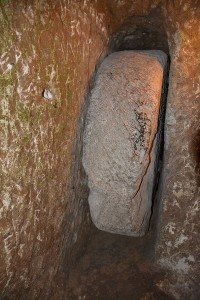 Larger rooms are connected by narrow walkways. There were even massive security doors made from stone that could be rolled across the passageways to block any invaders. It is not for anyone with claustrophobic tendencies. Sara made it to level two; Bob went to the lowest level. To think that between 3,000 and 10,000 people lived in these cities without electricity or running water for months at a time is mind boggling.
Larger rooms are connected by narrow walkways. There were even massive security doors made from stone that could be rolled across the passageways to block any invaders. It is not for anyone with claustrophobic tendencies. Sara made it to level two; Bob went to the lowest level. To think that between 3,000 and 10,000 people lived in these cities without electricity or running water for months at a time is mind boggling.
In Goreme, we wandered through another underground city, which is now called the Open Air Museum, a Byzantine monastic settlement from the 17th century. The people in this area created the underground city in rock formations that stood up from ground level. 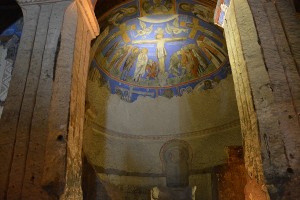 What was most amazing is the detail that was carved into the rock to simulate the freestanding buildings that they were accustomed to. Entire cathedrals were carved inside the rock complete with pillars as if they were supporting the structure. Equally impressive were the amazing frescoes adorning the walls, still mostly intact. To think that all this structure, including homes, government buildings, etc. were all created out of view so life could go on as it had before the Ottoman invaders came.
What was most amazing is the detail that was carved into the rock to simulate the freestanding buildings that they were accustomed to. Entire cathedrals were carved inside the rock complete with pillars as if they were supporting the structure. Equally impressive were the amazing frescoes adorning the walls, still mostly intact. To think that all this structure, including homes, government buildings, etc. were all created out of view so life could go on as it had before the Ottoman invaders came.
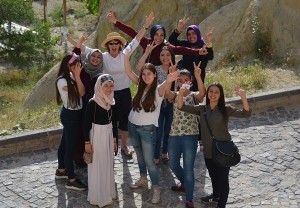 While in the Open Air Museum we noticed a group of high school girls that seemed to be squeezing into each space with us rather than dropping back or going ahead of the traffic flow. After an hour or so, several walked past Sara saying ¨hello¨. When Sara responded to them, they clustered around with great excitement, wanting to know if we were Americans. They had never met an American. Out came the cell phones and everyone wanted a selfie with the American. One of the girls spoke limited English so she was put in the lead. They were full of questions and shared the two phrases they knew – “American dream” and “We love Obama”. We learned they are from a village in northeast Turkey which is quite insolated. They wanted us to come to their village so their mothers could make us a meal and a salad with the herbs from their village.
While in the Open Air Museum we noticed a group of high school girls that seemed to be squeezing into each space with us rather than dropping back or going ahead of the traffic flow. After an hour or so, several walked past Sara saying ¨hello¨. When Sara responded to them, they clustered around with great excitement, wanting to know if we were Americans. They had never met an American. Out came the cell phones and everyone wanted a selfie with the American. One of the girls spoke limited English so she was put in the lead. They were full of questions and shared the two phrases they knew – “American dream” and “We love Obama”. We learned they are from a village in northeast Turkey which is quite insolated. They wanted us to come to their village so their mothers could make us a meal and a salad with the herbs from their village. 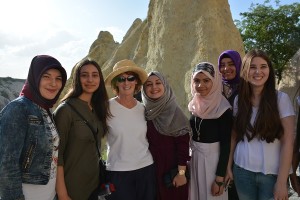 Their enthusiasm was effusive. It would have been a great experience to see their village, but not possible on this trip. It also showed the similarity of teens in the U.S. and Turkey: Several asked if we did Instagram and wanted to be Facebook friends. We sidestepped those offers.
Their enthusiasm was effusive. It would have been a great experience to see their village, but not possible on this trip. It also showed the similarity of teens in the U.S. and Turkey: Several asked if we did Instagram and wanted to be Facebook friends. We sidestepped those offers.
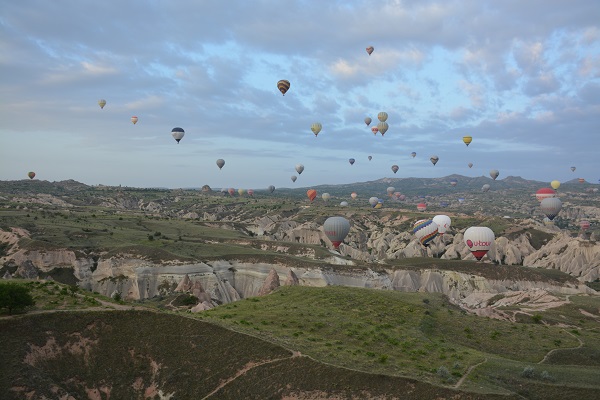 The big highlight of our trip was hot air ballooning over Cappadocia at sunrise. Generally there are 20+ people in a balloon basket, but ours had just 5 of us and a wonderful pilot with perfect English and a passion for sharing his knowledge of the balloon and how it works. We peppered him with questions as we drifted gently over the fairy chimneys. At one point he skillfully brought the balloon down between several fairy chimneys maneuvered back out again.
The big highlight of our trip was hot air ballooning over Cappadocia at sunrise. Generally there are 20+ people in a balloon basket, but ours had just 5 of us and a wonderful pilot with perfect English and a passion for sharing his knowledge of the balloon and how it works. We peppered him with questions as we drifted gently over the fairy chimneys. At one point he skillfully brought the balloon down between several fairy chimneys maneuvered back out again. 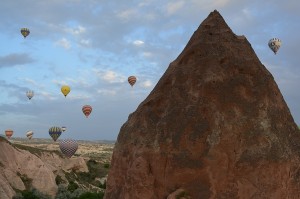 He told us that this was a special challenge they like to do called ¨dancing with the rocks¨. We continued our extraordinary experience floating over more unique rock formations and rippled ravines with spectacular views of the region as the backdrop.
He told us that this was a special challenge they like to do called ¨dancing with the rocks¨. We continued our extraordinary experience floating over more unique rock formations and rippled ravines with spectacular views of the region as the backdrop. 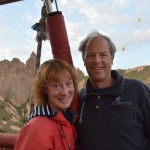 Our pilot brought the balloon down gently and landed it directly on the trailer attached to the truck that tows it. Pretty cool!
Our pilot brought the balloon down gently and landed it directly on the trailer attached to the truck that tows it. Pretty cool!
